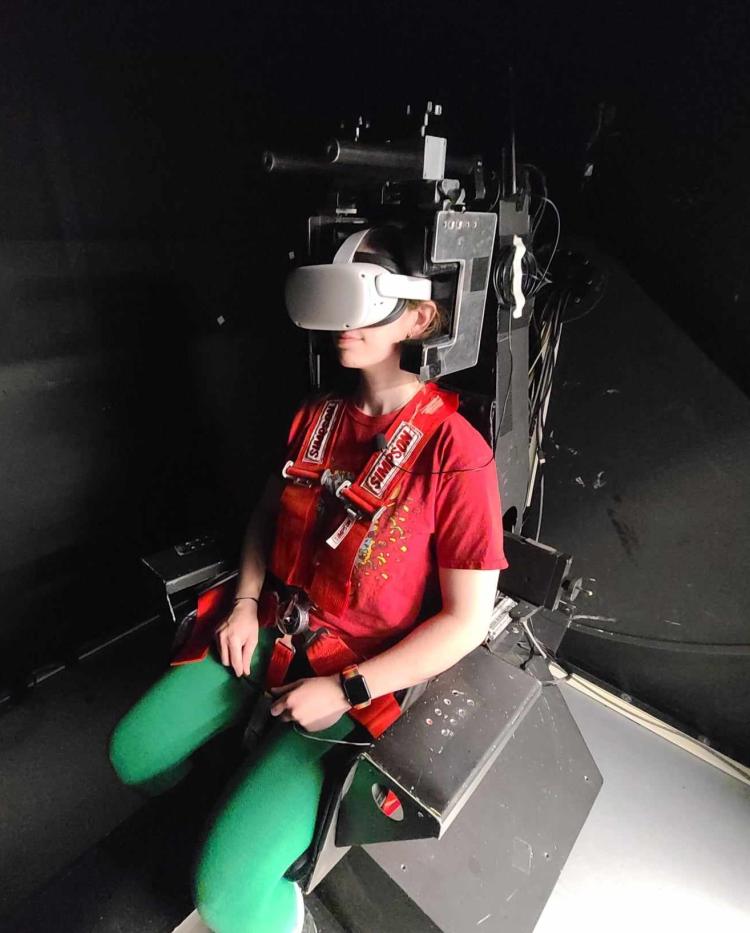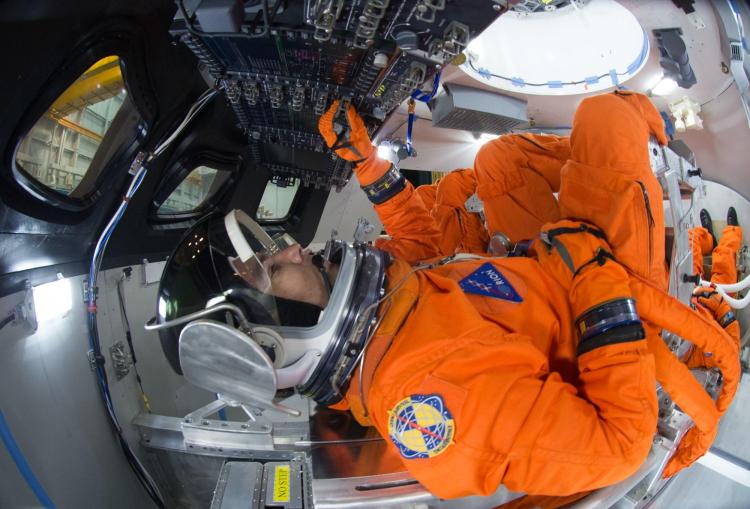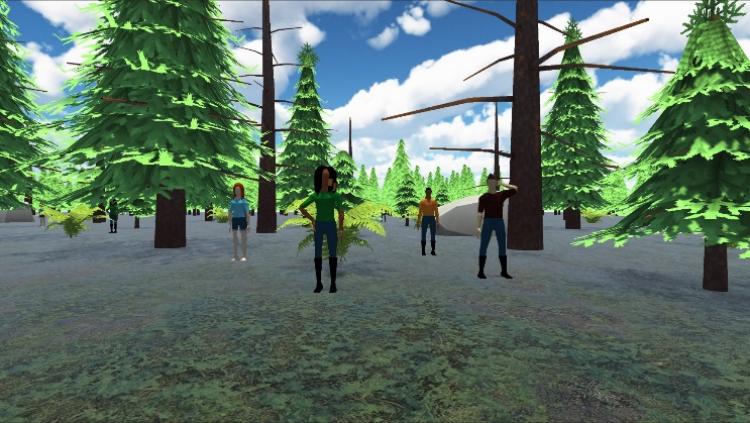In a corner room of the Aerospace Engineering Sciences Building at CU Boulder, Torin Clark is about to go for a ride.
The associate professor straps himself into what looks like an intimidating dentist's chair perched on metal scaffolding, which, in turn, rests on a circular base. The whole set up resembles a carnival attraction.
Which, in a way, it is.
Motion sickness and space
By the numbers
60%-80%
Percentage of space travelers who experience space motion sickness.
2-3 days
Typical length of a bout of space motion sickness.
86%
Percent of astronauts who reported vomitting as a symptom of their space motion sickness in a survey from the 1980s. Other common symptoms included anorexia (78%), headache (64%), stomach awareness (61%) and malaise (58%).
27%
Percent of Russian cosmonauts who experienced "readaption syndrome," similar to symptoms of motion sickness, upon their return to Earth.
"Torin, are you ready to start?" calls out graduate student Taylor Lonner from in front of a monitor displaying several views of Clark. "I'm going to go to 5 r.p.m. over two minutes."
Clark gives a thumbs up and begins to spin-first slowly, then faster and faster. The chair whips in circles around the room, creating a centrifugal force that forces his body back into the headrest.
Once the machine slows down and Clark is back on solid ground, he seems a little wobbly but in otherwise good spirits.
"It basically feels like a gravitron," he says, referring to the spinning, nausea-inducing rides that became a staple of county fairs in the 1980s.
The team from the Ann and H.J. Smead Department of Aerospace Engineering Sciences is using this machine as one step in an experiment that seeks to recreate an experience that few people ever have: The shock of going from one gravity environment, like space, to another, like the surface of Earth. In particular, the group is tackling what happens when astronauts return home, landing in their spacecrafts in the middle of a choppy ocean.
Disorientation and motion sickness have long been an underappreciated reality of space exploration, Lonner said. Surveys suggest that a majority of astronauts and cosmonauts have gotten sick during water landings-a relatively minor condition that could become dangerous if nauseous crew members suddenly have to respond to a disaster.
Addressing such motion sickness will become increasingly important as more people travel into space, and stay there for long, Lonner said. In recent lab experiments, the team discovered that virtual reality goggles might help keep astronauts grounded when they splash down in the ocean. This technology can provide people with calming images of a landscape to gaze at, similar to watching the horizon from the deck of a boat.
The team presented its results this month at NASA's annual Human Research Program Investigators' Workshop in Galveston, Texas.
"We're increasing this whole bubble of space exploration," Lonner said. "But people aren't going to want to do that if they're just going to be miserable when they get to microgravity and when they return to Earth."
Adrift at sea
For the aerospace engineer, the question is a personal one-she can't so much as crack a book open during car rides without getting queasy. According to one hypothesis, motion sickness like hers arises from a sort of mismatch between the body and brain.
"When you're in a moving environment, your body senses your surroundings, but your brain also holds an expectation for what you should be sensing based on your past experiences," Lonner said. "When those two things disagree for an extended period of time, you get motion sick."
Graduate student Taylor Lonner dons a virtual reality headset inside the Tilt-Translation Sled, a machine that, in experiments, can mimic the motion of ocean waves. (Credit: Taylor Lonner)
Engineers try out the cockpit of the Orion spacecraft, with a few porthole windows above their heads. (Credit: NASA/Robert Markowitz)
Unfortunately for astronauts, space is full of those kinds of contradictions.
When humans first break free of Earth's atmosphere, for example, their brains expect their bodies to experience a downward tug from gravity-conditions that don't exist in space. As a result, roughly 60% to 80% of space travelers have experienced what scientists call "space motion sickness," which can last for a few days or even longer. (Russian cosmonaut Gherman Titov holds the dubious honor of being the first human to vomit in space when he lost his lunch inside the Vostok 2 spacecraft).
In separate research, Clark and his colleagues are exploring whether space explorers can reduce space motion sickness through simple exercises, such as careful tilts of the head.
But icky feelings may also emerge when astronauts come back to Earth. NASA is planning to send humans to the moon this decade aboard the Orion or Dragon spacecrafts. When Orion, in particular, returns to Earth, it will likely plop into the ocean somewhere off the coast of California. There, astronauts may bob up and down in the waves for as long as an hour while they wait for rescue.
It's not a pretty picture, Lonner said: "If you look at Orion and Dragon, there are only a few porthole windows that really aren't sufficient for giving astronauts a fixed view of Earth."
Walk in the forest
Back at CU Boulder, in a lab down the hall from the human centrifuge, Clark steps into a different machine.
The metal cube painted blue is about the size of a small bedroom. It previously resided at NASA's Johnson Space Center in Houston and is so big that the team had to bring it into the building in pieces, then put it back together on site.
Once Clark secures himself to a chair inside and shuts the door, the massive device rumbles to life and begins to move, sliding along a track on the floor. It swishes in a straight line from one end of the room to the other for several minutes.
"You feel like you're getting rocked back and forth," Clark says.
In fact, it feels like being rocked back and forth by waves-the researchers programmed the sled's motion by drawing on data from real buoys in the Pacific Ocean.
In one recent experiment, the team took a two-stage approach to simulating the motion sickness that comes from water landings: First, the group spun 30 human subjects for an hour in the centrifuge. That spinning mimics the disorientation astronauts experience when they suddenly transition from microgravity to the harshness of Earth's gravity.
Next, the researchers rocked the subjects in the sled for as much as an hour. If that sounds like a recipe for nausea, Lonner said, it was.
But, she added, the team also gave each of the subjects a pair of virtual reality goggles to wear. Half of the subjects saw an image of a fixed white dot against a black background. But the other subjects received a much richer picture-a digital forest complete with a few cartoon humans for scale. Those forests also moved in tandem with the sled. When it slid or tilted, so did the trees and people.
"It's like a virtual window," Lonner said.
It also did the trick. Lonner explained that if subjects experienced moderate symptoms of motion sickness for longer than two minutes, they exited the experiment. Only a third of the people wearing goggles showing just the white dot lasted for the entire hour in the sled. In contrast, nearly 80% of subjects watching the forest survived the ordeal.
A window opens
The researchers are working to build on their results, exploring, for example, whether adding more information to the forest scene can help reduce nausea even more. But they are optimistic that virtual reality could give astronauts returning to Earth a little relief.
Lonner sees the project as a way of opening space exploration up to more people-including people like her who get nauseous on airplanes. She's even used some of the lessons from her research in her own life.
"I realized that it's worse when the window is closed, and I can't see the clouds passing by," Lonner said. "Now, I'll always open the window to watch the clouds."









